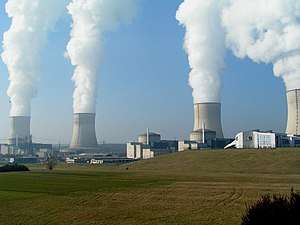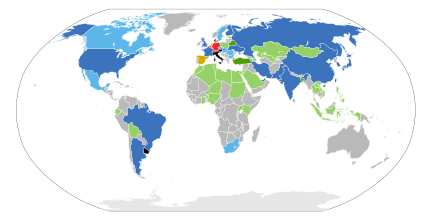Nuclear power by country
Nuclear power plants currently operate in 30 countries[2]. Most are in Europe, North America, East Asia and South Asia. The United States is the largest producer of nuclear power, while France has the largest share of electricity generated by nuclear power. In 2010, before the Fukushima Daiichi nuclear disaster, it was reported that an average of about 10 nuclear reactors were expected to become operational per year, although according to the World Nuclear Association, of the 17 civilian reactors planned to become operational between 2007 and 2009, only five actually came on stream.[3] Global nuclear electricity generation in 2012 was at its lowest level since 1999.[4][5]

China has the fastest growing nuclear power program with 11 new reactors under construction,[6] and a considerable number of new reactors are also being built in India, Russia and South Korea. At the same time, at least 100 older and smaller reactors will "most probably be closed over the next 10–15 years".[3] Pakistan plans on constructing three to four nuclear power plants by 2030.[7]
Some countries operated nuclear reactors in the past but have currently no operating nuclear plants. Among them, Italy closed all of its nuclear stations by 1990 and nuclear power has since been discontinued because of the 1987 referendums on which Italians voted. Kazakhstan and Armenia are planning to reintroduce nuclear power in the future. Belarus has its first nuclear power plant under construction and plans to have it operating by the end of 2020. The project is financed by Russia.[8]
Several countries are currently operating nuclear power plants but are planning a nuclear power phase-out. These are Belgium, Germany, Spain, and Switzerland. Other countries, like Netherlands, Sweden, and Taiwan are also considering a phase-out. Austria and the Philippines never started to use their first nuclear plants that were completely built.
Due to financial, political and technical reasons, Cuba, Libya, North Korea, and Poland never completed the construction of their first nuclear plants, and Australia, Azerbaijan, Georgia, Ghana, Ireland, Kuwait, Oman, Peru, Singapore, and Venezuela never built their planned first nuclear plants.[9][10] As of 2020 Poland is in advanced planning phase for 1.5 GWe and plans to have up to 9 GWe by 2040.[11]
Overview



|
Operating reactors, building new reactors Operating reactors, planning new build No reactors, building new reactors No reactors, planning new build |
Operating reactors, stable Operating reactors, considering phase-out Civil nuclear power is illegal No reactors |

Of the 31 countries in which nuclear power plants operate, only France, Slovakia, Ukraine, and Hungary use them as the source for a majority of the country's electricity supply as of 2019. Other countries have significant amounts of nuclear power generation capacity.[2] By far the largest nuclear electricity producers are the United States with 809,359 GWh of nuclear electricity in 2019, followed by France with 382,403 GWh.[2] As of December 2019, 455 reactors with a net capacity of 392,779 MWe are operational, and 54 reactors with net capacity of 57,441 MWe are under construction. Of the reactors under construction, 11 reactors with 10,564 MWe are in China and 7 reactors with a capacity of 4,824 MWe are in India.[13]
| Country | Reactors | Capacity Net-total (MWe) |
Generated electricity (GWh) |
Share of total electricity use |
Notes | |
|---|---|---|---|---|---|---|
| operational | U/C | |||||
| 3 | 1 | 1,641 | 7,927 | 5.9% | ||
| 1 | 0 | 375 | 2,029 | 27.8% | ||
| 0 | 2 | N/A | N/A | N/A | ||
| 0 | 2 | N/A | N/A | N/A | ||
| 7 | 0 | 5,930 | 41,422 | 47.6% | Phase-out planned | |
| 2 | 1 | 1,884 | 15,224 | 2.7% | ||
| 2 | 0 | 2,006 | 15,869 | 37.5% | ||
| 19 | 0 | 13,554 | 94,854 | 14.9% | ||
| 48 | 11 | 45,518 | 330,122 | 4.9% | ||
| 6 | 0 | 3,932 | 28,581 | 35.2% | ||
| 4 | 1 | 2,794 | 22,915 | 34.7% | ||
| 58 | 1 | 63,130 | 382,403 | 70.6% | ||
| 6 | 0 | 8,113 | 71,866 | 10.1% | 2022 Phase-out, 2018 data | |
| 4 | 0 | 1,902 | 15,415 | 49.2% | ||
| 22 | 7 | 6,255 | 40,740 | 3.2% | ||
| 1 | 1 | 915 | 5,866 | 1.8% | ||
| 38 | 2 | 36,476 | 65,682 | 7.5% | Many reactors currently stopped | |
| 25 | 4 | 23,833 | 138,809 | 26.2% | ||
| 2 | 0 | 1,552 | 10,881 | 4.5% | ||
| 1 | 0 | 482 | 3,701 | 3.2% | ||
| 5 | 2 | 1,318 | 9,066 | 6.6% | ||
| 2 | 0 | 1,300 | 10,368 | 18.5% | ||
| 39 | 4 | 28,448 | 195,535 | 19.7% | ||
| 4 | 2 | 1,814 | 14,282 | 53.9% | ||
| 1 | 0 | 688 | 5,533 | 37.0% | ||
| 2 | 0 | 1,860 | 13,603 | 6.7% | ||
| 7 | 0 | 7,121 | 55,856 | 21.4% | ||
| 8 | 0 | 8,592 | 64,429 | 34.0% | ||
| 5 | 0 | 3,333 | 25,370 | 23.9% | Gradual Phase-out planned | |
| 5 | 2 | 4,448 | 31,147 | 13.4% | ||
| 0 | 1 | N/A | N/A | N/A | ||
| 15 | 2 | 13,107 | 78,144 | 53.9% | ||
| 0 | 4 | N/A | N/A | N/A | ||
| 15 | 2 | 8,923 | 51,032 | 15.6% | ||
| 98 | 2 | 99,648 | 809,359 | 19.7% | ||
| World total | 455 | 54 | 392,779 | 2,586,000 | ||
See also
References
- "World Nuclear Power Reactors & Uranium Requirements". World Nuclear Association. 1 October 2010. Retrieved 23 October 2010.
- "Nuclear Share of Electricity Generation in 2019". IAEA. 27 June 2020. Retrieved 28 June 2020.
- Michael Dittmar. Taking stock of nuclear renaissance that never was Sydney Morning Herald, 18 August 2010.
- WNA (20 June 2013). "Nuclear power down in 2012". World Nuclear News.
- "The Nuclear Renaissance".
- "China Nuclear Power - Chinese Nuclear Energy".
- "Pakistan plans to build several new nuclear reactors - official". www.reuters.com. Retrieved 24 December 2019.
- World Nuclear Association. Nuclear Power in Belarus World Nuclear Association, May 2020.
- Duroyan Fertl (5 June 2011). "Germany: Nuclear power to be phased out by 2022". Green Left.
- James Kanter (25 May 2011). "Switzerland Decides on Nuclear Phase-Out". New York Times.
- Wilczek, Maria (16 June 2020). "Construction of Poland's first nuclear power plant to begin in 2026". Notes From Poland. Retrieved 18 June 2020.
- "Operational & Long-Term Shutdown Reactors". IAEA. 13 April 2013. Retrieved 14 April 2013.
- Nuclear Power Reactors in the World (PDF). Vienna: International Atomic Energy Agency. 2020. ISBN 978-92-0-101418-4.
- https://www.nek.si/en/about-nek/production